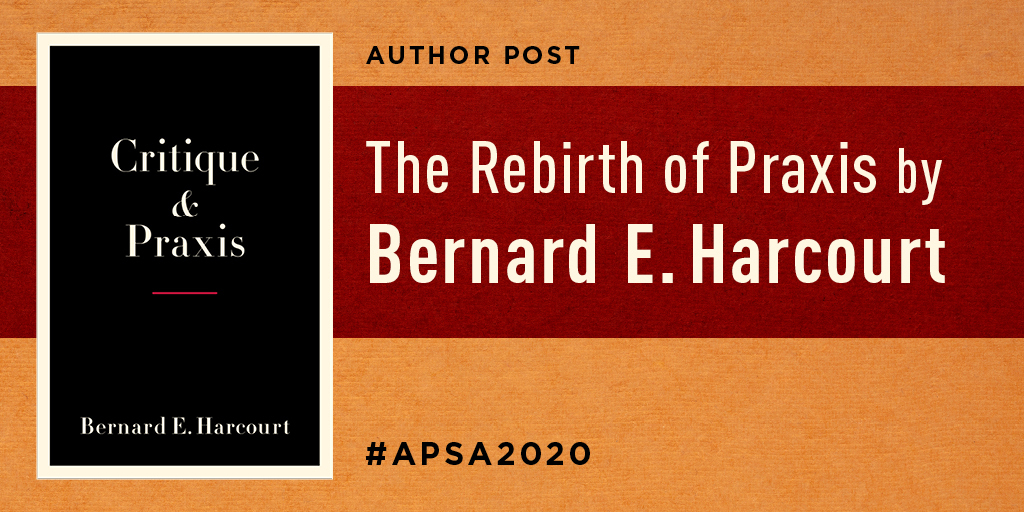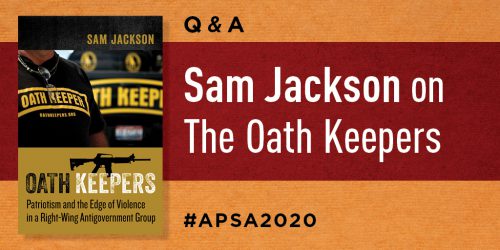The Rebirth of Praxis
By Bernard E. Harcourt

“With his typical combination of erudition, eloquent argument, and theoretical clarity, Bernard Harcourt now gives us a complete account of his reading of contemporary critical philosophy, articulating it with immediate issues in the field of human rights and democratic politics. A tour de force which will give readers much to learn and much to think about. I will have it permanently on my desk, or not far.”
~Étienne Balibar, author of Violence and Civility: On the Limits of Political Philosophy
We’re wrapping up our APSA 2020 virtual exhibit with this thought-provoking post by Bernard E. Harcourt, author of Critique and Praxis. Critique and Praxis advocates for a new path forward that constantly challenges each and every one of us to ask what more we can do to realize a society based on equality and justice.
• • • • • •
Life has been hell in this country. For many, especially persons of color, it has been hell for decades, or rather, centuries. But it has taken a turn for the worse since mid-March, again especially for persons of color, who have suffered disproportionately during this pandemic—or I should say, during this series of plagues, including the outbreak of COVID-19; the economic crash and massive unemployment that followed; the onslaught of police killings of George Floyd, Breonna Taylor, Carlos Ingram-Lopez, and others; and the proto-fascist response of President Donald Trump.
There is no silver lining. None.
But what we have seen, since that horrific eight-minute-and-forty-six-second video of the murder of George Floyd, is an uprising for Black lives like we had rarely seen before, not only in the United States but also across the globe, and a reckoning—however too late and too little—with structural racism in this country.
In the wake of the movement for Black lives, Americans of all stripes are quickly becoming familiar with a world of critical praxis and radical experimentation that has historically been outside the mainstream. Occupations, temporary autonomous zones, flash mobilizations, street riders, riots, antifascist strategies, walls of moms and leaf-blower dads—new and creative forms of protest are becoming headline news on mainstream media across the country.
That’s a change. It’s high time.
“A renewed and rejuvenated conversation about critical praxis is flourishing in the United States…”
A renewed and rejuvenated conversation about critical praxis is flourishing in the United States, inspired in part by the earlier experiments at Occupy Wall Street and #BlackLivesMatter, by Bernie Sanders’s call for political revolution, and by the Hong Kong protests, the Yellow Vest movement in France, and the occupations at Tahrir Square and Gezi Park earlier in 2011. Political protest is sometimes contagious, and these protest movements have breathed new life into political resistance—and also into critical theory.
Here too, it is high time. For too long, critical theory was burrowing down an epistemological detour from its true ambition: to change the world. It had retreated to the earlier task of only interpreting the world—with Gramsci’s idea of cultural hegemony; the Frankfurt School’s critique of ideology; Louis Althusser’s notes on ideological state apparatuses; Foucault’s theories of knowledge-power and, later, regimes of truth; Derrida’s deconstructive practices. Brilliant, all, but these theories distracted critical theory from its true ambition.
It is time to get back to that ambition, to get out of the epistemological detour and move forward. It is time—I argue, past time—to imagine a new critical praxis theory for the twenty-first century. This is the task that the book Critique and Praxis has set for itself: to counter decades of contemplative complacency and to return praxis to its central place in critical philosophy.
In the process, Critique and Praxis investigates the wide range of new forms of protest and resistance that are being deployed today—to think through them and learn from them.
“It is time to get back to that ambition, to get out of the epistemological detour and move forward.”
One important such praxis is temporary autonomous zones or TAZs. We saw these emerge recently in New York City at City Hall and in Seattle in Capitol Hill. They were indeed “temporary” insofar as they were shut down and evicted by police forces, as was Occupy Wall Street. TAZs, like other protest experiments, have both strengths and weaknesses and can be highly controversial. That was certainly true in Seattle. But it is precisely by engaging such forms of critical praxis that we will move forward and achieve the ambition of changing the world.
In Seattle, protesters transformed a six-block area of the city into a self-proclaimed “autonomous zone” free of policing and official government oversight, originally called the Capitol Hill Autonomous Zone (CHAZ). As the debate over autonomous zones began to overshadow the protest movement for Black lives, the protesters renamed the zone the Capitol Hill Occupied Protest (CHOP), in an effort to keep the focus of the national and local conversation on the entrenched racism, violence, and oppression in American society.
The debate over autonomous zones should certainly not displace the more important protest and national conversation about policing, structural racism, and #BlackLivesMatter. Nor should it overshadow the immediate struggle against the unconscionable and omnipresent violence against Black and Brown bodies—the still unexamined legacy of slavery in this country.
Autonomous zones are one important way to instantiate and prefigure the type of social arrangements that could displace our current racist and punitive society. Like the CHOP in Seattle, they can serve as experiments in new forms of governing. In the CHOP, community members were trying a society without police. This raises a number of challenges, but given the increasingly prominent and justified calls to abolish or defund the police, the CHOP was a rare opportunity to envisage how the many functions that have devolved to the police can be reassigned to other, nonpunitive institutions, such as mental health, sanitation, and social services.
“The effort to move forward and get beyond a police state will require reimagining social relations.”
The effort to move forward and get beyond a police state will require reimagining social relations. A first step in that direction is to experiment with new forms of democratic decision making, resolving disagreements and disputes, and addressing social problems. Autonomous zones provide the space for that experimentation. It need not and certainly will not be errorless—and has not been. But that is the value of experimentation, after all: to learn from the successes but also the errors of new iterations.
Autonomous zones have a long and storied history. In recent times, we have seen vibrant autonomous communities, for example, loosely at least, at Zuccotti Park during Occupy Wall Street; but these experiments trace back of course to venerable historical episodes like the Paris Commune in 1871 or the Zapatista communities dating to the 1990s.
Autonomous zones today consist most often in nonviolent, separatist social movements that seek to create community and self-government, often through a squatting model. They produce new forms of community, new conceptions of property, and innovative collaborations. The participants’ ambition of usually to avoid the formal structures of state control and policing.
The name “temporary autonomous zone” emerged in homage, in part, to the poetic writings of Hakim Bey in a book by that title, published in 1991. These movements can also aspire to be permanent, or become “Permanent TAZs,” as Bey himself suggested in a 1994 article, again by that title.
A well-known example of a TAZ that attempted to become a permanent autonomous zone is Notre-Dame-des-Landes, outside Nantes, France. That zone and others in Rouen, Lyon, and elsewhere in France are referred to as Zones à défendre or ZADs in French. They have generally involved peaceful occupations of land, often with a strong environmental and ecological dimension.
“Autonomous zones today consist most often in nonviolent, separatist social movements that seek to create community and self-government, often through a squatting model.”
In the case of Notre-Dame-des-Landes, the zone began as a protest movement against the building of a new, large airport outside Nantes to service all of western France. The physical presence of the protesters, through a form of squatting on agricultural lands where the airport was going to be built, started a long-term alliance among leftist activists, anarchists, environmentalists, and local farmers.
The Notre-Dame-des-Landes ZAD eventually brought down the airport construction project, after ten years of occupation and protest. In the process, the activists invented new forms of nonproperty, which the French state has tried to violently repress and demolish.
Hakim Bey’s The Temporary Autonomous Zone (1985) offers a seductive, poetic vision of this kind of separatism: a romantic vision drawing on the imagination of the pirate alcove, the fugitive, the bohemian artist living in a liminal space. For Bey, it is a reaction against the modern revolutionary ideal and an embrace, instead, of separation and insurrection. Bey explains the appeal: “The concept of the TAZ arises first out of a critique of Revolution, and an appreciation of the Insurrection. The former labels the latter a failure; but for us uprising represents a far more interesting possibility, from the standard of a psychology of liberation, than all the ‘successful’ revolutions of bourgeoisie, communists, fascists, etc.”
On this reading, a TAZ allows people to experiment outside or beyond the conventional state structures—in this case, especially, punitive state institutions like the police. “In the end the TAZ is almost self-explanatory,” Bey writes. “If the phrase became current it would be understood without difficulty . . . understood in action.”
The CHOP in Seattle was ambitious. It aimed not only to abolish the police but also to de-gentrify the neighborhood, properly fund community health, and dismantle mass incarceration. Some of the posted demands included prison abolition, expunging criminal records, and prisoner enfranchisement. But most important, the apparent goal of the CHOP was, in continuity with the movement for Black lives, to end the unconscionable violence against Black and Brown bodies in this country. Those ambitions were ultimately shut down by a hypermilitarized police force that looked like the occupying force in a counter-revolution.








